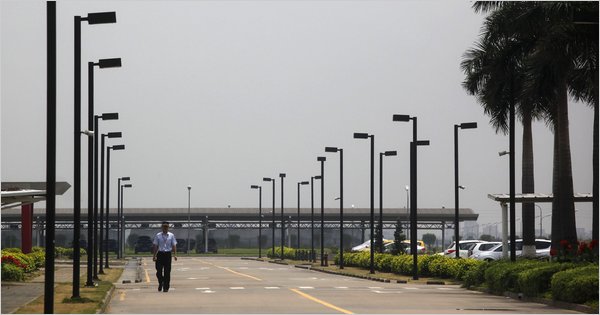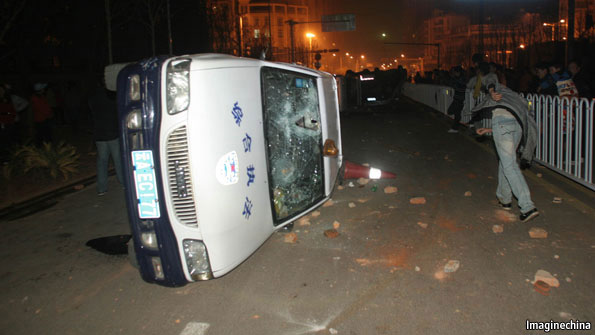 |
|
Honda manufacturing plant in
Foshan, Guangdong Province
|
Foshan,
China – After years of being pushed to work 12–hour days,
six days a week on monotonous low–wage assembly line tasks,
China’s workers are starting to push back.
A
strike at an enormous Honda transmission factory here in
southeastern China has suddenly and unexpectedly turned into
a symbol of this nation’s struggle with income inequality,
rising inflation and soaring property prices that have put
home ownership beyond the reach of all but the most affluent.
And
perhaps most remarkably, Chinese authorities let the strike
happen – up to a point.
In
the kind of scene that more often plays out at strikes in
America than at labor actions in China, print and television
reporters from state–controlled media across the country
have started covering the walkout here, even waiting outside
the nearly deserted front gate on Thursday and Friday in
hope of any news. All the Chinese reporters disappeared on
Saturday morning, however, as the government, apparently
nervous, suddenly imposed without explanation a blanket ban
on domestic media coverage of the strike.
A
worker at a factory dormitory said on Saturday afternoon
that the strike continued, and police were nowhere in sight
at the factory or the dormitory. The authorities have been
leery of letting the media report on labor disputes, fearing
that it could encourage workers elsewhere to rebel. The new
permissiveness, however temporary, coincides with growing
sentiment among some officials and economists that Chinese
workers deserve higher wages for their role in the
country’s global export machine.
And
without higher incomes, hundreds of millions of Chinese will
be unable to play their part in the domestic consumer
spending boom on which this nation hopes to base its next
round of economic growth.
“This
is all because there is a major political debate going on
about how to deal with the nation’s growing income gap,
and the need to do something about wages,” said Andreas
Lauffs, a lawyer at Baker & McKenzie who specializes in
Chinese labor issues.
If
wages do rise, that could bring higher prices for Western
consumers for goods as diverse as toys at Wal–Mart and
iPads from Apple.
The
Chinese media may also have found it a little easier,
politically, to cover this strike because Honda is a
Japanese company, and anti–Japanese sentiment still
simmers in China as a legacy of World War II. Certainly, the
strike is hitting Honda hard, as the resulting shortage of
transmissions and other engine parts has forced the company
to halt production at all four of its assembly plants in
China.
Honda
has an annual capacity of 650,000 cars and minivans in
China, like Jazz subcompacts for export to Europe and Accord
sedans for the Chinese market. Because Honda’s prices in
China are similar to what it charges in the United States,
the cars tend to be far out of reach financially for most of
the workers who make them.
A
Honda spokeswoman declined to discuss specific issues in the
strike negotiations.
The
intense media coverage may evoke historical memories of the
1980 shipyard strike in Gdansk, Poland, that gave rise to
the Solidarity movement and paved the way for the fall of
Communism in Eastern Europe. But the reality here is much
different.
Instead
of tens of thousands of grizzled and angry shipyard workers,
the Honda strike involves about 1,900 mostly cheerful young
people. And the employees interviewed say their goal is more
money, not a larger political agenda.
“If
they give us 800 renminbi a month, we’ll go back to work
right away,” said one young man, describing a pay increase
that would add about $117 a month to an average pay that is
now around $150 monthly. He said he had read on the Internet
of considerably higher wages at other factories in China and
expected Honda to match them with an immediate pay increase.
Many
workers at other factories in southeastern China already
earn $300 a month, but they do so only through considerable
overtime. And even that higher income is not enough to
embark on the middle–class dream in China of owning a
small apartment and subcompact car. Officially, though, the
government is discouraging heavy reliance on overtime, and
workers here said that Honda was not assigning much.
The
strikers said that Honda mainly hired recent graduates of
high schools or vocational schools. And so, most are in
their late teens or early 20s, representing a new generation
of employees, many of whom had not been born when the
Chinese authorities suppressed protests by students and
workers in Tiananmen Square in 1989 – a watershed event
whose 21st anniversary falls next Friday.
The
profile of striking workers seems to run more along the
lines of slightly bookish would–be engineers – perhaps
without the grades or money to attend college – rather
than political activists. Besides their low wages, the
workers seem focused on issues like the factory’s air–conditioning
not being cool enough, and the unfairness of having to rise
from their dormitories as early as 5:30 for a 7 a.m. shift.
Workers
said that in addition to their pay, they also received free
lodging in rooms that slept four to six in bunk beds. They
also get free lunches, subsidized breakfasts for the
equivalent of 30 cents and dinners for about $1.50.
The
striking employees said that some senior workers, known as
team leaders, had allied themselves with management. But
they insisted that the rank–and–file workers were
solidly in favor of walkout – a claim impossible to verify.
Although
China is run by the Communist Party and has state–controlled
unions, the unions are largely charged with overseeing
workers, not bargaining for higher wages or pressing for
improved labor conditions. And they are not allowed to
strike, although China’s laws do not have explicit
prohibitions against doing so.
Workers
at the Honda factory dormitory said that the official union
at the factory was not representing them but was serving as
an intermediary between them and management. Li Jianming,
the national spokesman for the All China Federation of Trade
Unions, declined to comment.
The
workers here have been on strike since May 21, with no
resolution in sight. But the strike did not come to broader
notice until Thursday and Friday as Japanese media began
reporting the shutdown of Honda assembly plants, and as
Chinese media and Internet sites were allowed to report
extensively on those activities.
The
unusually permissive approach of the authorities toward
media coverage of the strike follows a decision to tolerate
extensive coverage this month of suicides by workers at the
Taiwanese–owned Foxconn factory complex in nearby Shenzhen
that supplies Apple and Hewlett–Packard.
The
official China Daily newspaper ran a lead editorial on
Friday that cited the Honda strike as evidence that
government inaction on wages might be fueling tensions
between workers and employers. The editorial criticized the
Ministry of Human Resources and Social Security for not
moving faster to draft a promised amendment to current wage
regulations because of what the newspaper described as
opposition from employers.
Zheng
Qiao, the associate director of the department of employment
relations at the China Institute of Industrial Relations in
Beijing, said the strike was a significant development in
China’s labor relations history and that “such a large–scale,
organized strike will force China’s labor union system to
change, to adapt to the market economy.”
(*) Keith
Bradsher reported from Foshan, China, and David Barboza from
Shanghai. Bao Beibei contributed research.
 |
|
The violence in Kunming reportedly left dozens injured
|
Beijing.–
Altercations between unlicensed street vendors and law–enforcement
officers are commonplace in China. Sometimes they escalate
into scuffles or riots. But a night–time rampage by
hundreds of citizens in the southern city of Kunming,
capital of Yunnan province, on March 26th–27th has aroused
fresh concerns about a malaise in Chinese cities.
The
violence in Kunming reportedly left dozens injured. Ten
government vehicles were overturned and some set on fire by
crowds enraged by rumours that a vendor had been killed by
an officer of Kunming’s “City Administration and Law
Enforcement Bureau”. This agency, commonly known by its
Chinese abbreviation chengguan, is a junior cousin to the
police force. It is responsible for matters such as clearing
the streets of illegal pedlars and supervising house
demolitions. Chengguan officers are renowned for their
thuggish, fine–gouging ways.
The
vendor, as it turned out, had not been killed. But the
rioters could be forgiven for assuming the worst. In the
past couple of years even some state–controlled newspapers
have made common cause with critics of chengguan activities
across the country. In January 2008 a man in the central
province of Hubei was beaten to death when he attempted to
film officers trying to stop a protest by villagers against
a dump for urban waste. “Another citizen has fallen. When
will we stand up and restrain the chengguan system?” wrote
a newspaper columnist at the time.
The
Chinese press has reported others having fallen to the
chengguan since: a pedlar left severely brain–damaged
after a mauling in Shanghai last July; a man beaten to death
in Beijing in October after being accused of illegally using
his motorcycle as a taxi. One case prompted a letter to
China’s legislature. A woman in the province of Sichuan
died last November after setting herself on fire in protest
when officers burst into her home to enforce a demolition
order. In response, a group of Beijing law professors wrote
proposing tighter controls on demolition procedures.
Protests
triggered by chengguan brutality have rattled the
authorities, hypersensitive as they are to any urban unrest
that might turn against the government. Last May hundreds of
university students protested in the eastern city of Nanjing
against the alleged beating of a classmate. The following
month police rescued several chengguan who were captured by
rioters in a town in the southern province of Guangdong. In
Kunming last October protesters put the corpse of a pedicab–driver,
who had allegedly been killed by chengguan, on a gurney and
wheeled it to a chengguan office where they burned paper as
a traditional funeral offering (the authorities said he had
died naturally). That same month a Shanghai man became
famous when he chopped off part of a finger in protest at
what he said was an attempt to frame him as an illegal
taxi–driver.
The
latest flare–up in Kunming has also attracted considerable
press attention. One newspaper website described the
eruption as symptomatic of public resentment against local
officialdom that could blow up like “a bomb at any
time”. Another newspaper attacked the Kunming authorities
for releasing only bare details and not taking questions at
a press briefing on the incident. A third suggested the
official version of events, that the vendor had simply
fallen over, might be a “lie” (a word even used in the
headline). It quoted witnesses saying an officer had pushed
over her pedicab, pinning the woman under it. A gas canister
had then rolled on top of her, knocking her unconscious.
In
recent weeks, a speech on social unrest by a prominent
Chinese scholar, Yu Jianrong, has been widely circulated on
the internet in China. In it Mr Yu describes the emergence
in recent years of a new type of social unrest, which he
calls “venting incidents”: brief, unorganised outbursts
of public rage against the authorities or the wealthy.
China’s efforts to enforce “rigid stability”, he
argues, were not sustainable and could result in “massive
social catastrophe”. Even government officials, he notes,
are giving warning in private of worse to come.